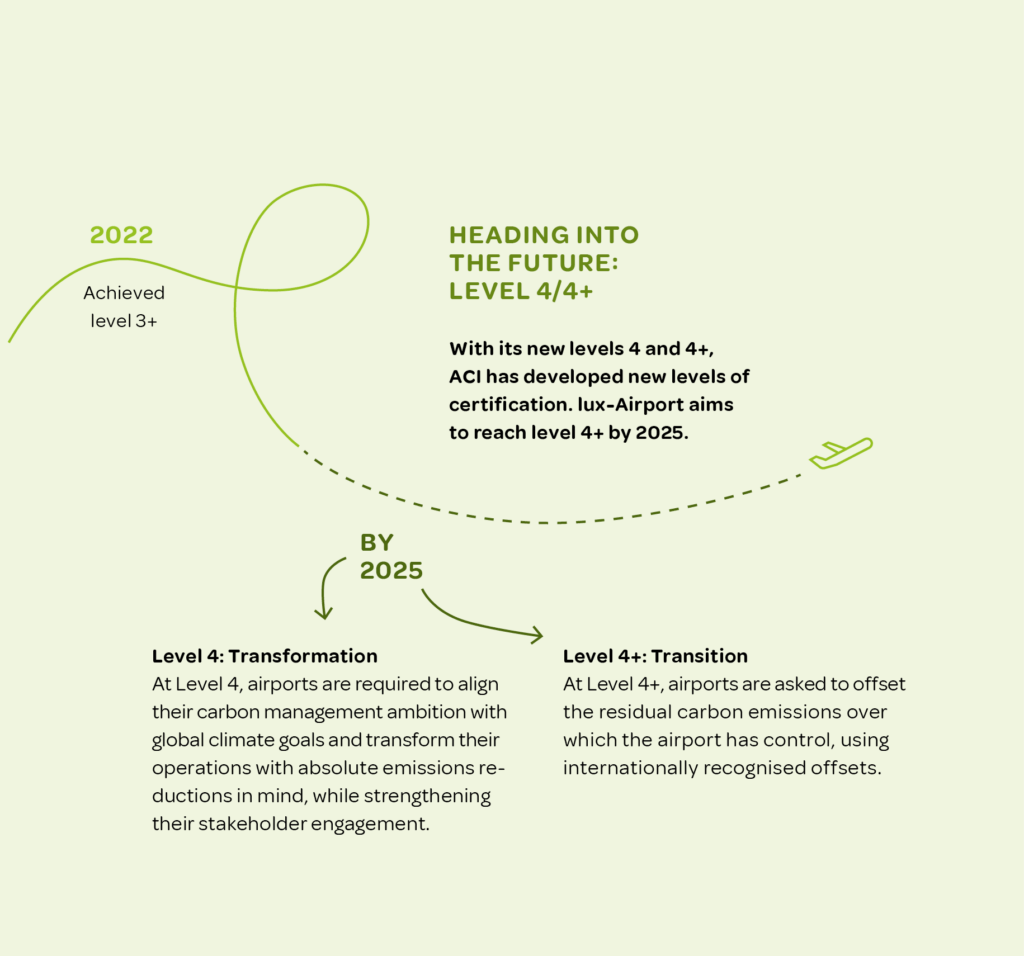OUR GOALS
1. Net Zero 2030 Commitment
lux-Airport actively promotes the production and use of renewable energy and since 2014, buying only renewable energy specifically, 100% hydroelectricity. The commitment to the Airport Carbon Accreditation programme means that we aim to achieve the neutrality specified by the level 3+ requirement in 2022. lux-Airport plans to reach the level 4+ requirement by 2025, as defined in the roadmap to reach real neutrality by 2030. The first star in the Lean & Green certification was awarded in 2019 and the second star is planned for 2025. In parallel, lux-Airport is strongly committed to reducing its energy consumption with a dedicated task force. Each new project includes renewable energy.
2. Water Management
Located in three different ground water protection areas, lux-Airport is working closely with the dedicated entities to ensure the ground water’s quality, as well as taking steps towards developing environmental emergency management procedures to avoid any risk. The management of wastewater, currently being improved by new facilities, is reinforced by the removal of the de-icing water directly on stand to optimise the treatment.
3. Waste Management
lux-Airport is continuously working to reduce the waste production at source: it strives to stop single-use plastic by promoting re-usable items, increases the recycling rate and searches for new solutions for recycling and recovering. The management is certified by the SuperDrecksKescht label.
4. Soil Mangement
lux-Airport is developing a land-use plan for the various different zones, enabling the necessary anti-pollution measures to guarantee a healthy environment and prevent contamination. For each project, the soil quality is analysed and restoration realised.
5. Biodiversity
The preservation of fauna and flora is taken into account in each new project and the necessary measures planned to avoid any kind of disturbance. The promotion of biodiversity involves a range of different projects, such as, developing beehives, creating new habitats, and improving the quality of environmental life by stopping the use of glyphosate anywhere in the airport.
6. Noise Managment
lux-Airport is conducting ground noise studies to define noise pollution and define an action plan. lux-Airport is also engaged in the airports noise advisory board in order to improve the noise environment for its neighbours.
7. Air Quality
Air quality on the ground is strongly linked to aircraft routes and vehicle use. Based on a ground air quality study, lux-Airport has identified areas for improvement and has already tested new technologies for reducing air emissions.

KEY FIGURES
We measure our sustainability-related performance by means of meaningful key figures. They document progress, but also indicate necessary improvements, and thus form the basis for managing our sustainability activities on our way to 100% sustainable business operations.

CARBON FOOTPRINT
Airport Carbon Accreditation level 3+
lux-Airport went directly from level 2 to level 3+ of the Airport Carbon Accreditation developed by ACI
Airport Carbon Accreditation is the global standard for carbon management in the airport industry. The aim of this programme is to encourage and enable airports to implement best practices in carbon management, with the ultimate objective of becoming net zero. The certification programme is part of the global airport industry’s response to the challenge of climate change.
lux-Airport reached level 2 Airport Carbon Accreditation in January 2020. Since then, the health crisis has greatly affected the aviation sector and, in particular, airport operations.
Despite this, lux-Airport has continued its efforts to reduce its carbon footprint and reach level 3+ on 1 February 2022.


Celebrating the ACA level 3+: lux-Airport shows a selection of its electric vehicles exclusively charged with 100% hydropower.
level 3: Actions taken
To achieve level 3 certification, lux-Airport has continued to reduce its relative carbon footprint, and at the same time has worked with the airport’s main partners, in particular those that make a significant contribution to the airport’s carbon emissions. Together, they have developed a common carbon footprint management system and have defined an action plan with measures to be applied in order to reduce this footprint.
Key Actions
Regulating engine use during taxiing (LTO = landing-take-off cycles)
Regulate APUs use on the apron
Energy efficiency
Some partners, such as Cargolux, have invested in renewing their fleet with more energy-efficient aircraft. The main handling company, Luxair, is also planning to transition to electric GSEs wherever possible.
Green electricity
In addition, the main players at the airport only use electricity produced from 100% renewable sources based on hydroelectricity. As a result, all electric charging stations are supplied with renewable energy.
Level 3+ offsetting project
Level 3+ represents the carbon neutrality achieved by lux-Airport by financially compensating for its carbon footprint with a project certified by recognised international organisations.
Kubratovo wastewater treatment plant
The project chosen to offset our 2020-2021 emissions is a combined methane emissions reduction and energy production project in Bulgaria. Methane produced in the Kubratovo waste-water treatment plant is captured in tanks and supplied to a CHP gas engine for electricity and heat production.

Kubratovo wastewater treatment plant
The impact
Dramatically reducing methane gas emissions
Reducing volume of sludge that needs to be transported
Electricity and heat production on-site, replacing supply from the grid and diesel usage

No reason to rest
ACI has developed new certification levels: levels 4 and 4+. The introduction of these two new levels marks a shift in the ambition of the programme. The set of stringent requirements include alignment with the Paris Agreement, the inclusion of additional emissions sources, in particular all significant operational emissions from third parties, and enhanced stakeholder engagement.

NUMBERS TO E-MOBILITY
New charging stations for electric vehicles have been installed in the underground car park at the terminal. We encourage the use of electrical vehicles airside.
A contract with a company renting only electric cars has been negotiated.
SAVINGS ON BUSES
Diesel bus = 110 t CO² / year
Electrical bus = 1 t CO² / year
Savings = 109 t CO² / year



